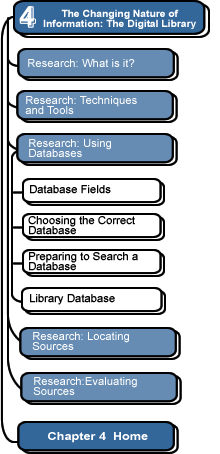

Using Databases
A database is a collection of data stored in fields that provides a means of retrieval of information based on search queries.
Information is stored in databases so that quick and accurate retrieval of individual records becomes possible. Imagine how difficult it would be to find books in Calvin's library if they were only arranged by their titles. How would you find books on a certain subject or by a particular author?
A database record
can be structurally simple or complex, as shown in this ![]()
Because of the limited number of books a library collects each year, it is possible for a library to maintain a database of its own holdings, such as the Hekman Library's WebCat at Calvin College. However, because hundreds of thousands of journal articles are produced annually, the library purchases research databases that contain records for far more articles than are in a college's library. Because a third party produces and sells these databases, when you find a citation in a research database, the library may not own the article.
The Hekman Library provides access to more than 150 research databases from the Research Databases page. Combined, these database contain more than 100 million records for articles, books, journals, and government documents.
![]()
![]()
These pages were
written by Glenn Remelts.
and edited by Jeffrey L. Nyhoff and Nancy Zylstra
©2005 Calvin University (formerly Calvin College), All Rights Reserved
If you encounter technical errors, contact computing@calvin.edu.